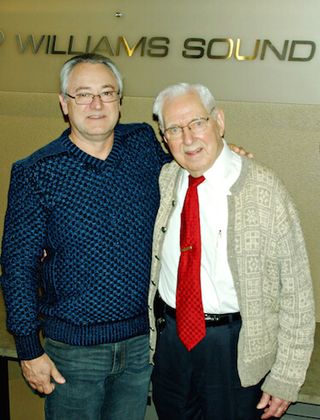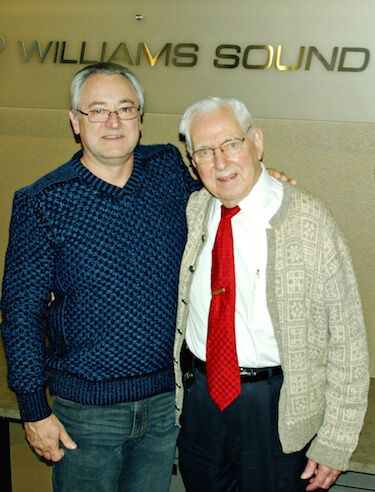
Williams Sound president and CEO Paul Ingebrigtsen (left) with founder Jerry Williams at the company’s 40th anniversary event.
Williams Sound held a reception to celebrate the company’s 40th anniversary on Thursday, February 25, offering an opportunity to reflect on its history of innovation in the field of assisted listening technology.
On hand was retired founder, Jerry Williams, who provided a brief retelling of the company history to those in attendance—which included a fair number of newer employees who hadn’t met him or had the chance to hear his story firsthand before, according to Williams Sound’s CEO, Paul Ingebrigtsen.
“[Williams] was an engineer by training and had been involved in the computer industry, and he was very active in his church and took care of the church sound system,” said Ingebrigtsen, recapitulating the story of the company’s founding. “And there were people with hearing loss in the congregation who couldn’t hear the sermons.”
So Williams went about developing a solution to help these parishioners hear better, and ended up with a system that utilized AM radio to distribute audio from the sound system to receivers with headsets. “It took the audio directly off the sound system, bypassing room acoustics, bypassing background noise,” Ingebrigtsen said. “In many ways they were getting the sound better than people with normal hearing were getting.”
Eventually the company expanded as more and more churches wanted to install his systems, and Williams and his wife Lorraine moved the company out of their home and into their first office. As growth continued, they began receiving inquiries from integrators about their products, leading to the creation of a dealer network to distribute and sell the products.
In the early 1980s, the lifting of FCC’s tight regulations on the use of FM frequencies led the company to develop a portable solution based on that radio band. “It took the products from installed solution—meant to be used by groups of listeners in an auditorium—to a portable system, for applications like guided tours,” said Ingebrigtsen. “And it could be in manufacturing facilities (noisy plants), or tourist attractions… anywhere you had a tour guide who was walking around with a group of people and giving them a presentation in a high-noise environment.”
Over time, the company continued to build on its success in the portable assisted listening market, expanding its offerings to solutions for schools, corporate, and government facilities. As it expanded, it adopted new technologies: infrared, digital, and induction loop transmission, to complement its core radio-based offerings.
“We really were the pioneer for wireless hearing assistance systems,” Ingebrigtsen said. “We brought the first frequency-adjustable systems to the market. We brought the first multichannel receivers to the market, which were adopted by conference companies for language interpretation use. We were among the early players in terms of a wireless system for language distribution. And more recently, the new technology we’ve brought into assisted listening products includes network connection and control and using mobile apps to set up and control the equipment, and using Dante digital inputs on them. So those are all features that had really not appeared in any assisted listening products prior to us introducing them.”
Ingebrigtsen, who was the company’s sixth employee when he joined in 1979, and has served as CEO since 1995, attributes the success of Williams Sound under his leadership to his dedication to maintaining the company’s culture, which he likens to a three-legged stool, with legs of internal employee satisfaction, customer satisfaction, and a high level of product innovation.
Going forward, Ingebrigtsen said the company’s plan is to continue to “pursue digital audio and digital radio solutions, being part of networked systems, embracing the use of mobile devices and BYOD, and expanding the applications for our equipment.” As an example of this planned expansion, he cited the suitability of the company’s Wi-Fi-based Hearing Hotspot product line for verticals such as hospitality, including hotels, restaurants, and bars, and transportation facilities, such as airports and train stations.
“We’re proud to be celebrating our 40th year and proud of the accomplishments and the many firsts that we’ve brought to the assisted listening space,” said Ingebrigtsen, in conclusion. “We expect to strengthen our leadership position and be here another 40 years.”











